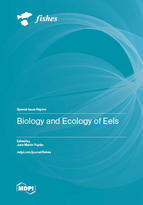Biology and Ecology of Eels
A special issue of Fishes (ISSN 2410-3888). This special issue belongs to the section "Biology and Ecology".
Deadline for manuscript submissions: closed (20 October 2023) | Viewed by 19169
Special Issue Editor
Interests: population genetics and genomics; invasive species; conservation biology; genetic variability; natural selection; evolutionary biology and ecology
Special Issue Information
Dear Colleagues,
We are currently inviting submissions of papers that address important questions to progress our knowledge and understanding of the biology and ecology of anguillid eels and ultimately contribute to a sustainable management solution of their populations in a global context. Anguillid eels have fascinated mankind for centuries due to of their complex life cycles and singular migration loops between freshwater and marine habitats. For over 30 years, there has been growing concern about the status of most anguillid eels, with declining stocks worldwide due to direct or indirect anthropogenic effects including overfishing, habitat loss, pollution, climate change, parasites and diseases. While considerable progress has been made in recent years to advance research in anguillid eels, there are still gaps in the knowledge, especially in the case of tropical anguillid eels. We invite papers and reviews on multidisciplinary topics in the broad field of biology and ecology, including biodiversity, systematics, phylogeography, population genetics, genomics and evolution.
Dr. Jose Martin Pujolar
Guest Editor
Manuscript Submission Information
Manuscripts should be submitted online at www.mdpi.com by registering and logging in to this website. Once you are registered, click here to go to the submission form. Manuscripts can be submitted until the deadline. All submissions that pass pre-check are peer-reviewed. Accepted papers will be published continuously in the journal (as soon as accepted) and will be listed together on the special issue website. Research articles, review articles as well as short communications are invited. For planned papers, a title and short abstract (about 100 words) can be sent to the Editorial Office for announcement on this website.
Submitted manuscripts should not have been published previously, nor be under consideration for publication elsewhere (except conference proceedings papers). All manuscripts are thoroughly refereed through a single-blind peer-review process. A guide for authors and other relevant information for submission of manuscripts is available on the Instructions for Authors page. Fishes is an international peer-reviewed open access monthly journal published by MDPI.
Please visit the Instructions for Authors page before submitting a manuscript. The Article Processing Charge (APC) for publication in this open access journal is 2600 CHF (Swiss Francs). Submitted papers should be well formatted and use good English. Authors may use MDPI's English editing service prior to publication or during author revisions.
Keywords
- anguillid eels
- biodiversity
- conservation biology
- evolution
- phylogeography
- population genetics
- genomics
- systematics
- management
- aquaculture






